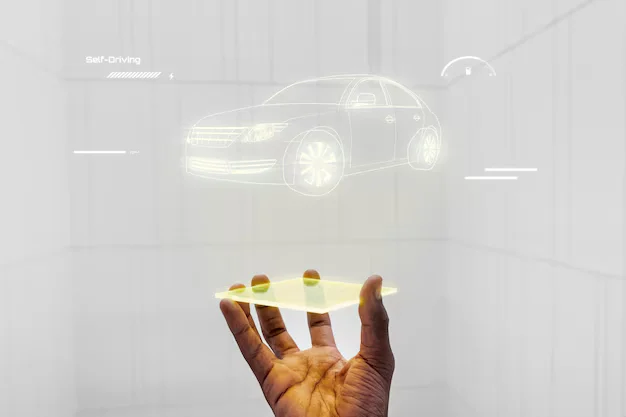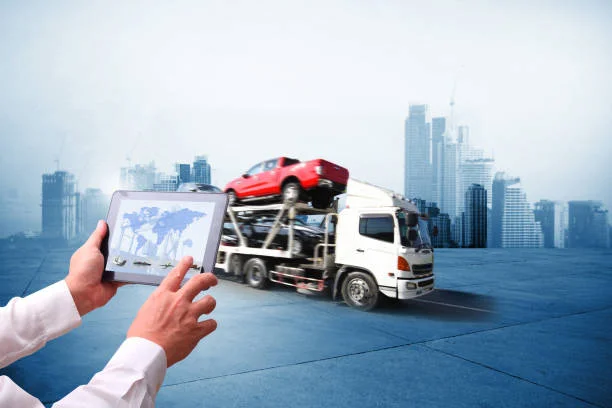AUTOMOTIVE
The Future of Automotive Safety Technologies

A New Era of Safety
The automotive industry is not merely evolving; it’s undergoing a transformational shift defined by a new era of safety. This transformation is catalyzed by groundbreaking technologies that redefine how vehicles protect their occupants. Modern advancements have made it possible for drivers and passengers to feel more secure on the road, thanks to features like lane-keeping assist, 360-degree cameras, and advanced computer systems that react faster than human reflexes. As potential buyers embark on the journey to discover these innovations, they are encouraged to browse our inventory to explore an array of options that incorporate the latest safety measures.
Gone are the days when the sole focus was on shielding the driver and passengers through rudimentary mechanical systems. Today’s landscape is characterized by smart safety technologies that actively collaborate with humans, ensuring that each journey is marked by confidence and security. This dynamic evolution underscores a narrative where safety is not an isolated feature but an integrated protocol that makes every drive safer and more enjoyable.
Key Takeaways
- Automotive safety technologies are rapidly advancing, offering new protective measures for drivers.
- Emphasis on innovative solutions like autonomous emergency braking and connected vehicle systems.
- Understanding the role of these technologies can help consumers make informed vehicle purchases.
Fundamentals of Automotive Safety
The fundamental principles of automotive safety lay the groundwork for today’s technological marvels. Organizations such as the National Highway Traffic Safety Administration (NHTSA) have long established stringent guidelines to mitigate fatalities on the road. Standard safety features like airbags, anti-lock braking systems, and seatbelts, once considered state-of-the-art, now form the baseline for modern automotive design.
However, these elements have not lost their significance. Instead, they have evolved to work synergistically with newer technologies, forming a holistic safety ecosystem. In addition to being historical trivia, this fundamental knowledge offers crucial insight for buyers who want to comprehend the state of the industry today and the developments influencing the vehicles of the future.
Emerging Technologies in Vehicle Safety
In the rapidly advancing world of automotive safety technologies, new features are designed to exceed the anticipations of modern consumers, essentially raising the bar for what is considered safe. Adaptive cruise control, automatic high beams, and collision prevention systems are transitioning from luxurious additions to indispensable prerequisites in vehicle design. Such cutting-edge technologies provide a safety net, allowing drivers to navigate roads with more assurance, as sensors and software assist in managing potential threats.
These measures are not just confined to the theoretical realm; they manifest in real-life driving scenarios, offering peace of mind even in adverse conditions. For example, a system that warns drivers when another car is in their blind area can save lives by preventing side-impact incidents. As innovation progresses, these advanced systems not only meet but exceed safety expectations on a global scale, pushing us closer to an era of virtually risk-free driving.
The Rise of Autonomous Emergency Braking
Among the cutting-edge advancements in automotive safety, autonomous emergency braking (AEB) stands out as a pivotal innovation. This technology represents a noteworthy leap forward in crash prevention, employing a sophisticated array of sensors and cameras to continuously scrutinize the road ahead. When a possible collision is detected, the AEB system steps in, applying the brakes autonomously if the driver doesn’t react promptly, thereby minimizing the impact or avoiding it altogether.
Empirical evidence underscores the effectiveness of this technology. A study by the Insurance Institute for Highway Safety (IIHS) reveals that vehicles equipped with AEB have seen a 50% reduction in rear-end collisions. Such statistics provide quantifiable proof of how technological advancements not only enhance road safety but also boost consumer confidence in new automotive technologies.
Connected Vehicle Systems: Enhancing Communication
Connected vehicle systems represent the epitome of networked innovation in the automotive sector. By employing vehicle-to-vehicle (V2V) and vehicle-to-infrastructure (V2I) communication, these systems provide drivers with real-time data to navigate roads more safely and efficiently. Imagine receiving instantaneous updates about slippery road conditions ahead or an alert to upcoming traffic congestion; this is the promise of connected vehicle systems.
Integration of this technology allows for proactive safety measures rather than reactive ones, enabling time-sensitive decisions that can avert accidents. As smart cities continue to develop, the role of connected vehicle systems becomes increasingly central to urban planning and road infrastructure. These technologies are on a promising path to revolutionize mobility, aiming for optimized routes and reduced overall risk for commuters.
Consumer Awareness and Demand for Safety Features
The automotive industry is witnessing a paradigm shift where consumer awareness around safety features is at an all-time high. More informed than ever, today’s buyers prioritize safety over other opulent characteristics, significantly affecting market trends and vehicle design philosophies. Many car manufacturers are channeling this momentum by ensuring that advanced safety elements like AEB systems and adaptive headlights are available not just in luxury models but across all ranges of vehicles.
This growing demand highlights a societal trend that values life and safety increasingly more than material luxury. It also challenges automakers to further their efforts in innovation, certifying that their vehicles are equipped with technologies that provide tangible benefits in real-world conditions. As consumers continue to place safety at the forefront, the industry must respond with enhanced offerings that meet these high expectations.
Future Trends in Safety Features
The trajectory of innovations within the automotive industry points towards a future filled with unprecedented advancements. From the increasing presence of advanced driver-assistance systems (ADAS) to the refinement of artificial intelligence applications, the horizon is abundant, with the potential for creating safer roads. Future trends focus on not only improving existing technologies but also introducing entirely new solutions that address broader safety concerns, including pedestrian and cyclist protection.
With these burgeoning technologies, automotive safety enters a new dawn where minimizing risks and maximizing protection becomes a universal blueprint. Stakeholders and consumers can get ready for a time when driving is associated with safety and technical sophistication by comprehending and embracing these trends. As the journey continues, the roads of tomorrow promise to be paved not just with asphalt but with innovation and security.
AUTOMOTIVE
Electric Outboard Motors: The Clean, Quiet, and Smarter Future of Boating

Boating enthusiasts around the world are witnessing a major shift in marine propulsion, and at the center of this transformation are electric outboard motors. These motors have rapidly gained popularity due to their efficiency, environmental benefits, low maintenance, and advanced performance capabilities. As technology continues to push boundaries, electric propulsion is not just an alternative to gas-powered engines—it is becoming the preferred choice for a new era of clean and sustainable boating.
Today, we explore everything you need to know about electric boating, why so many boaters are switching, and where to find premium electric outboard boat motors from trusted brands. This guide is designed to help you make a confident and informed decision while enhancing your boating experience for years to come.
What Are Electric Outboard Motors?
Electric outboard motors are propulsion systems powered by battery-stored electricity rather than gasoline. They use high-efficiency electric motors to drive a propeller, delivering smooth, silent, and eco-friendly performance on the water. Because they eliminate fuel combustion, they avoid the fumes, noise, and pollution common with traditional motors.
These motors have evolved significantly over the past decade, becoming more powerful, compact, and technologically advanced. Today’s designs offer:
- High torque output
- Long battery life
- Durable marine-grade construction
- Smart digital controls
- Fast charging capabilities
This combination makes them ideal for fishing boats, inflatable dinghies, pontoons, sailboats, small crafts, and more.
Why Electric Outboard Motors Are the Future of Boating
1. Zero Emissions and Eco-Friendly Operation
More lakes, rivers, and protected marine zones are regulating or banning combustion engines due to pollution. Electric outboard motors help boaters meet environmental standards without compromising performance. With zero emissions, they protect water quality, marine animals, and air purity.
2. Quiet and Smooth Ride
Noise is one of the biggest drawbacks of gas-powered engines. Electric motors eliminate engine roar—providing whisper-quiet performance. This is perfect for fishing, wildlife observation, relaxing cruises, and early morning rides.
3. Low Maintenance and Long Lifespan
Electric motors contain fewer moving parts than combustion engines. That means:
- No oil changes
- No spark plugs
- No carburetor issues
- No fuel filters
- No exhaust leaks
This results in significantly lower maintenance costs and fewer mechanical problems over time.
4. Lower Operating Costs
Electricity is far cheaper than gasoline. Combined with low maintenance needs, electric outboard boat motors offer exceptional long-term savings.
5. Instant Torque for Strong Acceleration
Electric motors deliver power instantly. Unlike gasoline engines that build power gradually, electric propulsion offers immediate thrust—ideal for quick takeoff, steering control, and smooth maneuvering.
How to Choose the Right Electric Outboard Motor
If you are planning to invest in electric outboard motors, consider the following factors to ensure optimal performance:
Battery Type and Capacity
Lithium-ion batteries are the industry standard thanks to their:
- Lightweight build
- Faster charging
- Longer lifespan
- Higher energy density
Choose a battery with enough capacity (measured in kWh or Ah) to support your typical boating duration.
Motor Power (kW / HP Equivalent)
Electric motors are rated in kilowatts, but many manufacturers provide horsepower equivalents. Match the motor power to your boat’s size, weight, and intended use.
Boat Size and Load
Larger boats require more thrust. Always select a motor designed to handle your typical passenger load and equipment weight.
Range and Runtime
Runtime depends on battery size and speed. For long journeys, consider portable backup batteries or high-capacity lithium packs.
Charging Options
Many motors now include:
- Fast chargers
- Solar charging compatibility
- Regenerative systems (on some hybrid models)
Choose a charging setup that aligns with your lifestyle and boating frequency.
Top Choice for High-Quality Electric Outboard Boat Motors
For boaters who want premium performance, durability, and smart engineering, Scott Electric Outboard is one of the most trusted names in the industry. Their lineup offers industry-leading efficiency and reliable long-term performance.
Whether you need a compact motor for a tender or a high-powered system for a larger craft, Scott Electric Outboard offers top-rated solutions backed by expert support.
Benefits of Choosing Scott Electric Outboard Motors
Scott Electric Outboard has earned a strong reputation for delivering modern, reliable, high-performance motors. Here’s why boaters trust them:
1. Superior Efficiency
Their motors are designed to maximize power output while extending runtime—allowing more hours on the water per charge.
2. Long-Lasting Marine-Grade Construction
Built with corrosion-resistant materials, these motors perform reliably in both fresh and saltwater conditions.
3. Smart Digital Features
Many models include:
- LED battery indicators
- Smart throttle systems
- GPS-integrated control
- Safety features like low-battery alerts
4. Eco-Friendly and Quiet
These motors are perfect for fishing, island hopping, wildlife tours, and recreational boating.
5. Trusted Mercury Electric Options
Their Mercury electric outboard lineup offers cutting-edge innovation with unmatched marine engineering quality.
Electric Outboard Motors vs. Gasoline Motors: Which Is Better?
Below is a comparison to help you evaluate the best choice for your needs:
| Feature | Electric Motors | Gas Motors |
| Noise Level | Ultra-quiet | Loud |
| Emissions | Zero | High |
| Maintenance | Very low | High |
| Operating Cost | Very low | Expensive |
| Lifespan | Long | Moderate |
| Eco-Friendly | Yes | No |
| Starting System | Instant start | Manual/electric start |
| Vibration | Minimal | High |
For most recreational users, electric motors offer superior advantages in comfort, reliability, and sustainability.
Applications of Electric Outboard Boat Motors
Electric propulsion is suitable for a wide variety of boating activities:
- Fishing trips
- Family cruising
- Dinghies & tenders
- Kayaks and inflatable boats
- Pontoons
- Sailboats (as auxiliary motors)
- Resorts & eco-tourism operations
- Rental fleets
- Wildlife and photography tours
Their silent performance and eco-friendly design make them ideal for peaceful and protected waters.
Final Thoughts: Why Now Is the Best Time to Go Electric
With rising fuel prices, tighter environmental regulations, and rapid advancements in battery technology, investing in electric outboard motors is one of the smartest boating decisions you can make today. These motors offer unmatched efficiency, quiet performance, and long-term savings—all while helping protect the environment.
Explore more articles built to elevate your mindset and unlock new possibilities.
AUTOMOTIVE
Science Behind The Best Inverter: How Technology Enhances Efficiency

For decades, home improvement solutions have transformed how people enhance their living conditions. From ACs to refrigerators, we have seen countless technologies. Among all, inverters have always been the best of human innovations, and most importantly for Indian homes, where electricity is often erratic. No one wants to drop out suddenly mid-way during work from home, or wait hours to get their digital equipment charged before use. That is when the inverter comes as a relief.
Today, this power-packed device is available in different advanced technologies and features, which not only enhance efficiency but also last longer for years. Therefore, find the best inverter tailored for different energy needs and usage. Sine wave and square wave are two most reliable and inverter types that you can use for your homes. This blog unfolds the best inverter types and how they maximise efficiency. Let’s get into the science behind them.
What is A Sine Wave Inverter and How is it a Reliable Upgrade
The Sine Wave inverters are designed to convert Direct current coming out from a battery into Alternating Current (AC). This current then impacts the electrons that help supply electricity in the waveform that arrives at the grid. The waveform provides current to the home appliance in a balanced form, ensuring they are not stressed. This advanced process makes the sine wave the best inverter and the correct choice for homeowners looking for a steady and efficient power supply. With the best brands, you get sine wave inverters that are one of their kind, integrating with AI technology and other advanced features for better performance. It offers smooth backup for all your sensitive and essential appliances like the refrigerators, ovens, and computers, uninterruptedly.
Key Features of the Sine Wave Inverter
Here are the best inverter features of Sine Wave that make them stand out:
1. Smooth Flow of Current:
The sine wave inverters are designed to deliver electricity in a wave pattern, which is exactly how appliances are built to accept current. This creates a smooth flow of electricity that enables devices to work as they were intended to. The result? You get uninterrupted electricity, keeping the performance of your device stable and balanced.
2. Stable Frequency and Voltage:
Not every piece of equipment is built the same. They come with different frequencies and voltage needs. The sine wave inverter strives to maintain this accuracy. Whether it is a simple device like a bulb or a much advanced machine like a microwave, every appliance receives a steady amount of voltage and frequency, keeping it functioning properly.
3. Energy Efficiency:
As your home appliances do not need energy from any additional operation, they consume energy in moderation. This helps you get more efficient power and makes the best use of electricity for enhanced performance.
4. Clean Power Supply:
One of the most effective benefits of a sine wave is its clean power supply without distortion. You do not want to see lights flicker after two minutes of power shortage or your computer go down due to slight variations. Clean and reliable electricity is most important for sensitive appliances like the sound system or laptop.
Square Wave Inverter and How They Work
It is easy to get the hint from the name that a square wave inverter releases power in the form of a square wave AC output. These are one of the most common types and are readily available in the market.
With its simple energy flow, they may not produce as clean an output as sine waves, but they are straightforwardly used for applications in systems that do not require high-quality power. The DC current in these inverters moves back and forth in a square wave pattern when you turn on and off the electric switches.
Today, the square wave integrates the best inverter features with its AI technology for efficient charging and consistent backup across all important appliances like lights, fans, and motors.
Notable Characteristics of Square Wave Inverters
This is how a square wave can be the best bet for homeowners looking for a secure electricity supply without facing hefty electricity bills.
1. Affordability:
A square wave inverter is not only for its simple operation but also for its budget-friendly range. It is significantly cost-effective than a sine wave inverter, making it easier for homeowners to invest in lower energy consumption of their essential appliances. In addition, it is designed to handle power surges, making it a good choice for devices that are not affected by fluctuations in power.
2. Compact Design:
The square wave is the best inverter choice for people with small home space. As these are made in a compact, simple design, they do not occupy much space in your home, being a perfect fit for apartments and average households.
Conclusion
Smart home inverters today can completely transform the house’s power backup. They are designed keeping in mind people’s changing lifestyles and habits. Meet your daily electricity needs, enjoy consistent power, and make a humble investment without burdening your savings!
Your journey continues—explore more topics that match your interests perfectly.
AUTOMOTIVE
The Smart Way to Compare Car Shipping Quotes Online in Minutes

The hardest part about writing a post on how to find the best way to ship a car would be titling it! Learning to compare car shipping quotes online can save you a lot of money and time, given the many options available.
To help make your experience as smooth and efficient as possible, this guide provides a few tips and tricks to hopefully streamline the process for you and make getting car shipping quotes online easier.
Understanding Car Shipping Basics
Before contacting a transport company, it is important to understand the basics of car shipping. Most providers offer two main options: open transport and enclosed transport. Open carriers are generally more affordable, while enclosed carriers offer greater protection for high-value or delicate vehicles. Knowing the difference helps you make a more informed and confident decision based on your needs and budget.
Defining Your Needs
The most important step is identifying requirements. Take into account the distance a vehicle is travelling, what kind of vehicle it is, and how soon you want it delivered. When you have an idea about what you need, it will be easy and accurate to compare.
Researching Reliable Companies
It is very important to choose a reliable company. Online reviews and ratings help us understand previous customers’ experiences. Find firms that have excellent feedback. It is also a good practice to verify proper licensing and insurance coverage.
Using Online Tools for Quotes
So, instead of going to the physical markets, consumers can get quotes very easily online, and the online platform gives them all the necessary information for making the right choice. The consumer goes to many websites, fills out information, and receives multiple quotes, usually within a few minutes. They provide a hassle-free means of comparing various options without millions of calls or endless emails.
Comparing Prices and Services
Price is undoubtedly an important factor, but it should not be the only one. Look at what is included with each quote—what insurance they provide, the time frame for delivery, and other fees. When you know everything about each of the offers, you can make a better decision.
Looking at Customer Support
Customer support is an important aspect of shipping. Companies that communicate well and are quick to respond are more likely to be reliable. You can tell a lot about how much a company cares about customer satisfaction by how it responds to questions and problems.
Evaluating Insurance Options
Insurance is a vital component when shipping cars. Make sure the coverage provided meets your personal needs. While the call is pretty basic, some companies will have really good plans. Knowing the terms and conditions of insurance policies is essential to help you in the future.
Reading Fine Print
Because there are no unpleasant surprises, reviewing terms and conditions saves you from the trouble. So be mindful of cancellation policies, extra fees, and delivery and pickup terms. This will help you avoid any miscommunication and make the transaction smooth.
Seeking Recommendations
Personal recommendations can be invaluable. You can get tips or advice from friends, family, or coworkers with experience using car shipping services. When it is your own experience, it gives a clear context and almost every time it shows something special that is not readily shown by the research on the internet.
Utilizing Social Media
Social media is a handy medium that, arguably, creates a demand for information. Numerous businesses are perpetually present in these spaces and frequently interact with customers. You can get a hint about how reliable they are and how well they will serve you by observing how a company interacts with people on social media.
Timing Your Booking
Timing can influence shipping costs. As a general rule, better prices come with early bookings and higher rates with last-minute arrangements. Seasonal demand can also influence pricing and availability.
Reviewing Multiple Quotes
Compare several quotes that will help you gather some perspective. Do not be tempted to settle on the first acceptable option you come across. Comparing numerous places gives you a sense of equilibrium and brings to the forefront the best offer.
Making an Informed Decision
Once you have everything you need, it becomes a simple case of making the right choice. Just make sure to weigh the pros and cons, whether it be the price, service, insurance, or the company’s reputation. The result of a passive take is mutually beneficial.
Conclusion
Getting online car shipping quotes to compare is a little more complicated than it should be. By identifying individual needs, studying companies, and using online tools, it will be a piece of cake. However, with some strategic thinking and proper planning, the right solution to your shipping needs is entirely attainable and profitable.

 BUSINESS10 months ago
BUSINESS10 months agoBrand Visibility with Imprint Now and Custom Poly Mailers

 HEALTH9 months ago
HEALTH9 months agoHappy Hippo Kratom Reviews: Read Before You Buy!

 HOME IMPROVEMENT9 months ago
HOME IMPROVEMENT9 months agoThe Do’s and Don’ts of Renting Rubbish Bins for Your Next Renovation

 TECHNOLOGY8 months ago
TECHNOLOGY8 months agoDizipal 608: The Tech Revolution Redefined

 BUSINESS10 months ago
BUSINESS10 months agoExploring the Benefits of Commercial Printing

 LIFESTYLE10 months ago
LIFESTYLE10 months agoThe Disciplinary Wives Club: Spanking for Love, Not Punishment

 HEALTH5 months ago
HEALTH5 months agoYour Guide to Shedding Pounds in the Digital Age

 ENTERTAINMENT2 months ago
ENTERTAINMENT2 months agoExploring the Kristen Archives: A Treasure Trove of Erotica and More












